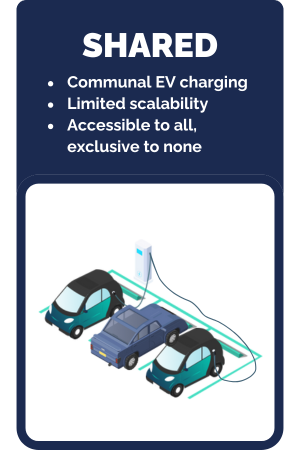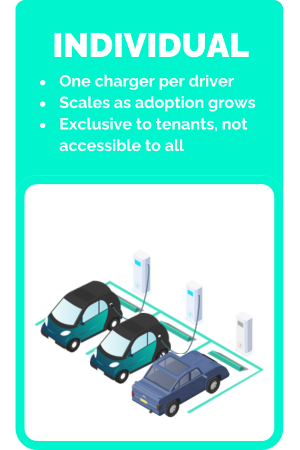A Complete Guide to EV Charging in Multi-Unit Buildings for Property Managers
This article was authored by ChargeGuru and was originally published on Flat Living.
Electric vehicle (EV) adoption is increasing at a rapid pace, with almost one-third of new car sales fully-electric (20.7%) or plug-in hybrid (9.2%) so far this year. By May 2025, already 2.3 million plug-in vehicles were on UK roads , accounting for over 6.5% of the circa 34 million cars on UK roads that are fully electric.
With the demand there and ever-growing, the Government & private investors are working towards improving the UK’s charging network. The number of public charge points grew from 28,460 at the end of 2021 to more than 73,000 by the end of 2024, and, since May 2024, the public network has grown by 30%.
However, with such a strong emphasis on developing the public charging network, the adoption of private charging infrastructure among landlords and property managers has been comparatively slow, leaving residents in apartment blocks and flats effectively excluded from this transition.
The role of property managers in the EVolution
Our most recent research data underscores this. We found that only 2% of property managers are considering installing EV charging in 2025, despite 74% of apartment residents considering access to EV charging crucial when choosing where to live, and EV adoption is quite clearly continually on the rise.
Our data suggests that property managers are unaware of the time it takes to install charging, with 71% of property managers believing that charger installation takes just three months, when in reality, timelines can be significantly longer. Similarly, 53% cited financial concerns as the biggest barrier, both upfront installation expenses and long-term operational costs, highlighting a lack of understanding of the solutions available to them.
That misunderstanding is contributing to stalled rollout plans. Considering the fact that EVs have a significantly lower average fuel cost than ICE cars when being charged at home, property managers must understand the EV charging solutions available to them to accelerate the transition to electric.
What is the right EV charging solution for your building?
Selecting the correct charging infrastructure requires careful consideration of building capacity, tenant needs, scalability and cost responsibilities. The two primary models available, shared charging and individual charging, each come with distinct benefits and challenges.
 Shared EV charging solutions
Shared EV charging solutions
Shared EV charging solutions are sometimes a practical first step for residential and multi-unit buildings, as they offer communal access to chargers typically installed in shared parking areas. Operating at speeds of up to 7.4 kW, and sometimes 22 kW where viable, these shared setups are generally sufficient for overnight charging. However, as EV uptake grows, shared chargers can become a pinch point, with limited scalability and increased demand among tenants.
To support tenants’ needs without overloading the building’s electrical capacity, we usually recommend load balancing technology, which helps distribute power intelligently and ensures consistent performance, even as usage increases. While some property managers choose to oversee these systems themselves, most opt for third-party management, such as EV charging partners, which reduces administrative strain and ensures safety and regulatory compliance.
Funding models are flexible. Costs can be covered upfront by the property or passed through service charges. Working with a third-party provider also simplifies fire safety compliance and insurance concerns, as they handle regular maintenance, liaise with insurers, and ensure installations meet required standards. Managing this in-house, on the other hand, often adds significant complexity and time commitments.
 Individual EV charging solutions
Individual EV charging solutions
In contrast, individual charging solutions provide a dedicated charger for each tenant or unit, making them highly scalable and better suited to future growth. With 7.4kW charging, tenants can reliably charge overnight, improving speed and ease to their driving, and guaranteed access boosts convenience and satisfaction. Like shared setups, load balancing remains essential, especially as more chargers are added.
Critically, individual systems should be managed by a third party. Asking residents to oversee their chargers not only adds complexity but also raises safety and insurance concerns. Fortunately, fully funded, third-party managed solutions are available, covering both infrastructure and installation at no cost to property managers. This allows property managers and freeholders to offer EV charging as a premium feature without investment or financial risk.
While residents can self-fund the entire installation, this route often brings coordination and standardisation challenges. Third-party partners streamline the process, ensuring compliance with safety regulations, managing ongoing maintenance and liaising with insurers to keep risks low and operations simple.
Final thoughts
In the end, the right approach depends on your property and your tenants’ needs. Shared charging may work for smaller sites, but for long-term flexibility and tenant satisfaction, individual charging is often the smarter choice. And with the right partner, it’s easier and more cost-effective than you might think – including fully-funded solutions.
Whether opting for shared or individual setups, now is the time to take action, as early adoption not only future proofs your property but also enhances tenant satisfaction and long-term property value.
Learn more about fully-funded EV charging solutions from ChargeGuru and discover if your building is eligible!





